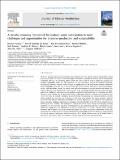| dc.contributor.author | Cooney, Ronan | |
| dc.contributor.author | Baptista de Sousa, David | |
| dc.contributor.author | Fernández-Ríos, Ana | |
| dc.contributor.author | Mellett, Sinead | |
| dc.contributor.author | Rowan, Neil | |
| dc.contributor.author | Morse, Andrew P. | |
| dc.contributor.author | Hayes, Maria | |
| dc.contributor.author | Laso, Jara | |
| dc.contributor.author | Regueiro, Leticia | |
| dc.contributor.author | Wan, Alex HL. | |
| dc.contributor.author | Clifford, Eoghan | |
| dc.date.accessioned | 2023-02-15T09:44:58Z | |
| dc.date.available | 2023-02-15T09:44:58Z | |
| dc.date.copyright | 2023-02-02 | |
| dc.date.issued | 2023 | |
| dc.identifier.citation | Cooney, R. Baptista de Sousa, D., Fernández-Ríos, Ana, Mellett, S.,Rowan, Neil, Morse, A.P.,Hayes, M., Laso, J., Regueiro, L., Wan, A. HL., Clifford. (2023).E. A circular economy framework for seafood waste valorisation to meet challenges and opportunities for intensive production and sustainability, Journal of Cleaner Production, 392, 136283, ISSN 0959-6526, https://doi.org/10.1016/j.jclepro.2023.136283. | en_US |
| dc.identifier.issn | 0959-6526 | |
| dc.identifier.uri | https://research.thea.ie/handle/20.500.12065/4386 | |
| dc.description.abstract | There is a growing concern among societies and consumers over food security and the sustainability of food production systems. For seafood, it has been highly advocated as a healthy food source and its sustainability credentials. However, the increasing global demand for seafood and the need to supply the quantities are creating sustainability issues, e.g., the importation of plant and marine proteins for aquafeed production. Consequently, there is a necessary need to analyse the supply chain and life cycle of these systems to determine their sustainability merits and how to enhance them. The circular economy (CE) aims to reduce processing by-product underutilisation, increase the rate of reuse, and reduce pressure on natural resources and systems. For seafood, there are large quantities of biomass that are being lost through bycatch/discards, waste from aquaculture (e.g., sludge and wastewater), and by-products generated through processing (e.g., trimmings and offal). These can all be valorised for the generation of feeds, value-added products, or further food production. This review will focus on seafood by-products generated during the processing into consumer products, and the current methods that could be used to manage or treat these waste streams. The review presents a stepwise framework that outlines valorisation opportunities for seafood by-products. This framework can enable producers, operators, regulators, and investors to integrate with the principles of the CE with the consideration of achieving economic viability. The challenges of seafood loss due to climate change and emerging recycling strategies will also need to be considered and integrated into the valorisation pathways. Communication, education, and engagement with stakeholders are key to transitioning to a circular economy. Where increase awareness and acceptance will create drivers and demand for seafood by-product valorisation. Overall, the impact of such a circular production system will potentially lead to higher production efficiency, reduce demand for natural resources, and greater seafood production. All of which addresses many of the United Nation's Sustainable Development Goals by contributing towards future food security and sustainability. | en_US |
| dc.format | PDF | en_US |
| dc.language.iso | eng | en_US |
| dc.publisher | Elsevier | en_US |
| dc.relation.ispartof | Journal of Cleaner Production | en_US |
| dc.rights | Attribution 3.0 United States | * |
| dc.rights.uri | http://creativecommons.org/licenses/by/3.0/us/ | * |
| dc.subject | Seafood loss | en_US |
| dc.subject | Aquaculture | en_US |
| dc.subject | Nutrient recovery | en_US |
| dc.subject | Seafood supply chain | en_US |
| dc.subject | Processing by products | en_US |
| dc.title | A circular economy framework for seafood waste valorisation to meet challenges and opportunities for intensive production and sustainability | en_US |
| dc.type | info:eu-repo/semantics/article | en_US |
| dc.contributor.affiliation | Technological University of the Shannon: Midlands Midwest | en_US |
| dc.contributor.sponsor | This work was supported by the EAPA_576/2018 NEPTUNUS project. The authors would like to acknowledge the financial support of Interreg Atlantic Area. A.H.L Wan was co-funded under the HYDROfish project (2019–2022) which was funded under the Disruptive Technologies Innovation Fund (DTIF), established under Project Ireland 2040, run by the Department of Enterprise Trade and Employment with administrative support from Enterprise Ireland. | en_US |
| dc.description.peerreview | yes | en_US |
| dc.identifier.doi | 10.1016/j.jclepro.2023.136283 | en_US |
| dc.identifier.orcid | https://orcid.org/0000-0002-3498-981X | en_US |
| dc.identifier.orcid | https://orcid.org/0000-0003-1228-3733 | en_US |
| dc.identifier.volume | 392 | en_US |
| dc.rights.accessrights | info:eu-repo/semantics/openAccess | en_US |
| dc.subject.department | Bioscience Research Institute TUS: Midlands | en_US |
| dc.type.version | info:eu-repo/semantics/publishedVersion | en_US |


